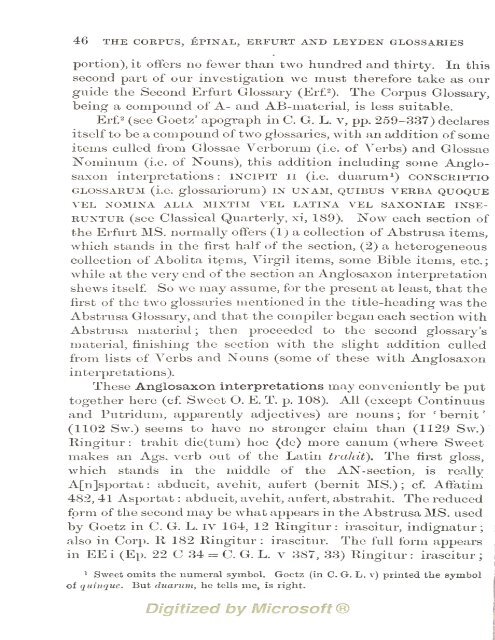the corpus, épinal, erfurt and leyden glossaries, viii - World eBook ...
the corpus, épinal, erfurt and leyden glossaries, viii - World eBook ...
the corpus, épinal, erfurt and leyden glossaries, viii - World eBook ...
Create successful ePaper yourself
Turn your PDF publications into a flip-book with our unique Google optimized e-Paper software.
46 THE CORPUS, EPINAL, ERFURT AND LEYDEN GLOSSARIES<br />
portion), it offers no fewer than two hundred <strong>and</strong> thirty.<br />
In this<br />
second part of our investigation we must <strong>the</strong>refore take as our<br />
guide <strong>the</strong> Second Erfurt Glossary (Erf^). The Corpus Glossary,<br />
being a compound of A- <strong>and</strong> AB-material, is less suitable. I<br />
Er£2 (see Goetz' apograph in C. G. L. v, pp. 259-337) declares'^<br />
itself to be a compound of two <strong>glossaries</strong>, with an addition of some<br />
items culled from Glossae Verborum (i.e. of Verbs) <strong>and</strong> Glossae<br />
Nominum (i.e. of Nouns), this addition<br />
including some Anglosaxon<br />
interpretations: INCIPIT II<br />
(i.e. duarum^) conscriptio<br />
GLOSSARUM (i.e. glossariorum) in unam, quibus verba quoque<br />
VEL NOMINA ALIA MIXTIM VEL LATINA VEL SAXONIAE INSEruntur<br />
(see Classical Quarterly, xi, 189). Now each section of<br />
<strong>the</strong> Erfurt MS. normally offers (1 j a collection of Abstrusa items,<br />
which st<strong>and</strong>s in <strong>the</strong> first half of <strong>the</strong> section, (2) a heterogeneous<br />
collection of Abolita items, Virgil items, some Bible items, etc.;<br />
while at <strong>the</strong> very end of <strong>the</strong> section an Anglosaxon interpretation<br />
shews itself So we may assume, for <strong>the</strong> present at least, that <strong>the</strong><br />
first of <strong>the</strong> two <strong>glossaries</strong> mentioned in <strong>the</strong> title-heading was <strong>the</strong><br />
Abstrusa Glossary, <strong>and</strong> that <strong>the</strong> compiler began each section with<br />
Abstrusa material ; <strong>the</strong>n proceeded to <strong>the</strong> second glossary's<br />
material, finishing <strong>the</strong> section with <strong>the</strong> slight addition culled<br />
from lists of Verbs <strong>and</strong> Nouns (some of <strong>the</strong>se with Anglosaxon<br />
interpretations).<br />
These Anglosaxon interpretations may conveniently be put<br />
toge<strong>the</strong>r here (cf. Sweet 0. E. T. p. 108). All (except Continuus<br />
<strong>and</strong> Putridum, apparently adjectives) are nouns ;<br />
for '<br />
bernit '<br />
(1102 Sw.) seems to have no stronger claim than (1129 Sw.)<br />
Ringitur : trahit dic(tum) hoc (de) more canum (where Sweet<br />
makes an Ags. verb out of <strong>the</strong> Latin trahit). The first gloss,<br />
which st<strong>and</strong>s in <strong>the</strong> middle of <strong>the</strong> AN-section, is<br />
really<br />
A[n]sportat : abducit, avehit, aufert (bernit MS.) ; c£ Aftatim<br />
482, 41 : Asportat abducit, avehit, aufert, abstrahit. The reduced<br />
form of <strong>the</strong> second may be what appears in <strong>the</strong> Abstrusa MS. used<br />
by Goetz in C. G. L. iv 164, 12 Ringitur: irascitur, indignatur;<br />
also in Corp. R 182 Ringitur : irascitur. The full form appears<br />
in EEi (Ep. 22 C 34 = C. G. L. v 387, 33) Ringitur: irascitur ;<br />
1 Sweet omits <strong>the</strong> numeral symbol. Goetz (in C. G. L. v) printed <strong>the</strong> symbol<br />
of quinque. But duarum, he tells me, is right.

















